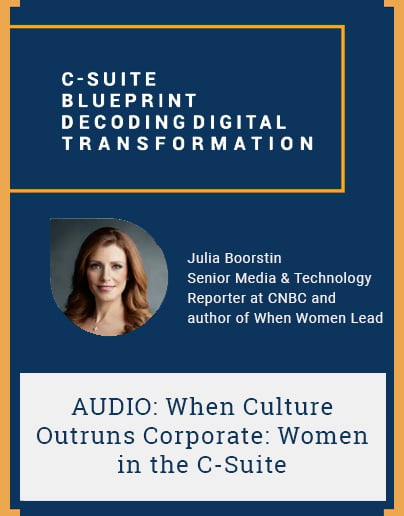Gender equality in America has undergone a cultural reckoning over the last decade.
But despite social trends like the MeToo movement helping pave the way for advancing women’s issues, Corporate America is still dragging its feet.
Julia Boorstin, Senior Media & Technology Reporter at CNBC and author of When Women Lead, believes there’s a diversity disconnect in the C-Suite.
Julia talked with us about:
- The low trajectory for gender equality in corporate America
- The false narrative around female leader stereotypes
- Why the lack of women in leadership roles breeds impostor syndrome
We Need More Women in the C-Suite
“The women I have met and interviewed are so inspiring. They are accomplishing so many phenomenal, remarkable, and surprising things. They make me optimistic.”— Julia Boorstin
Diversity, Equity, and Inclusion (DEI) has become a prevalent term in the professional lexicon in recent years.
But like any hot progressive initiative, talk is cheap.
“There has been cultural change,” Julia said. “But I think what's been frustrating for a lot of people is the disconnect between the perception of change and the amount of change there's actually been.”
For instance, the nearly seven percent increase in female executives from 2016 to 2021 might look like a win on paper. Yet, according to the 2022 Women CEOs in America report from the Women Business Collaborative, less than 10 percent of Fortune 500 CEOs are women today.
And as Julia told us, digging a little deeper will bring even more discouraging numbers to light.
“In venture capital funding, there’s been effectively no progress over the past decade,” she said. “About three percent of all venture capital dollars went to female founders. That declined to two percent in 2021, and it has continued to decline in 2022.”
On the corporate side, missed opportunities for women also tend to result from early setbacks. Julia pointed out a common obstacle in the promotion pipeline, as indicated by the joint study Women in the Workplace 2022 (McKinsey and Lean In).
“Women are missing the first promotion,” she said. “If they’re not getting the second promotion, then their chances of making it anywhere near the C-Suite are minuscule.”
The Gender Fallacy
“You can pick up on clues and work to be more empathetic, or you can work to be more vulnerable. Women may be more comfortable with those things, but everyone of any gender can work on these skills.”— Julia Boorstin
So, this grand failure begs the question: Why are so few women in leadership positions in an age when gender roles are steadily becoming passé?
Countless studies have shown that there is no biological basis accounting for any differences in leadership traits between men and women.
In her book, Julia discussed several social components regarding male and female leaders, one of which was divergent and convergent thinking.
She summarized the concept from a professional angle with a familiar idiom.
“Women are more likely to ask about the forest, whereas men are more likely to focus on fixing a problem with a particular tree,” Julia said.
In organizations where leadership values tactical speed over scalable solutions, this meta mindset could put women at a disadvantage.
“I think, culturally, we live in a society that’s always focused on the urgency of fixing a problem now,” Julia said.
Yet, she also points out that just because men are prone to attack imminent problems head on, that shouldn’t imply that women are less capable of doing so - quite the opposite.
“Women rank higher when it comes to adaptability,” Julia explained. “Women are better able to adapt and pivot when the situation changes because they’ve already taken the time to understand the forest.”
The Power of Pattern Matching
“I think it’s very important for all children to have a really diverse array of role models… Our kids need to see that, a lot of times, leaders are women.” — Julia Boorstin
As the trajectory of professional female leaders seems to be stagnating, Julia is concerned for women who may question their place in the C-Suite.
“I think that impostor syndrome really ties into the fact there’s lack of representation,” she said. “If you don’t see women in certain roles, both men and women are going to assume that women aren’t good in that role.”
And for Julia and other parents like her, there is legitimate concern about the future that could entail.
“It was mind-boggling to me… the power of pattern matching, this idea that people are always trying to fit the world into patterns that they see,” she said.
This distressing perception could very well draw out an unsettling reality in a corporate world dominated by men.
But Julia is hopeful for a future in which her children will work side by side with empowered women.
“As a mother of two boys, I think about the world I want them to live in and all the ways I want them to learn from the amazing women I wrote about,” she said.
When Women Lead
The C-Suite has a lot of work to do in giving women a fair shake.
But as evidenced by the powerful stories in her book, Julia is confident it can get better.
And it will be women leading the charge.
“The women I have met and interviewed are so inspiring. They are accomplishing so many phenomenal, remarkable, and surprising things,” she said. “They make me optimistic.”
Craving more? You can find this interview and many more by subscribing to C-Suite Blueprint on Apple Podcasts, on Spotify, or here.
